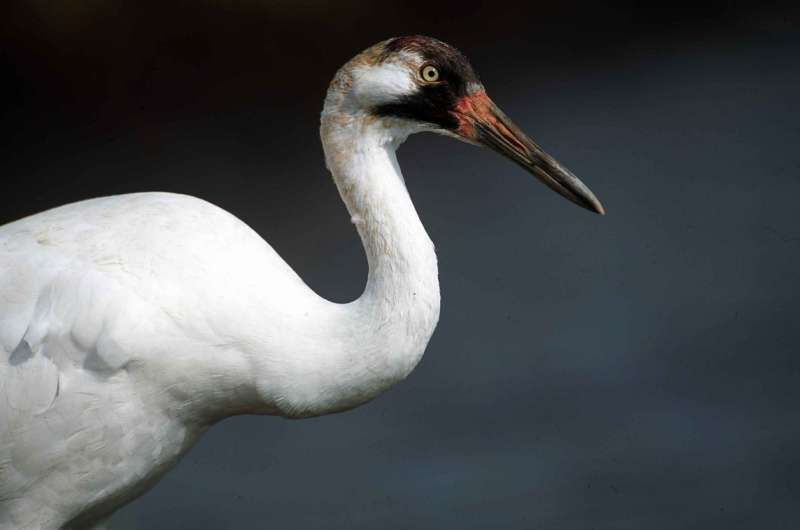Credit: CC0 Public Domain
A team of researchers from the U.S. and Germany has found that many whooping cranes pair up even before they are old enough to mate. In their paper published in the journal Animal Behavior, the group describes their study of the rare birds and offers some opinions on why the birds pair up so early and become mates for life.
Prior research has shown that whooping cranes, like several other bird species, bond with their mates for life. The practice, other research has shown, improves reproduction numbers and helps birds live longer because the paired mates look out for one another against predators and in some cases, help each other in foraging for food.
Sadly, whooping cranes are still quite rare after near extinction in North America back in the 1940s. Efforts to save them have resulted in a rising population, but they are still considered to be an extremely threatened species. These tall, long-legged white birds with red tipped heads and black tipped wing feathers have been the focus of several studies. In this new effort, the researchers attached monitoring devices to 89 of the birds reintroduced into the eastern U.S. back in 2001, and have been studying them ever since.
The researchers report that over the course of their study, they witnessed the development of 58 male/female partnerships. But what was surprising was that 62 percent of those partnerships started before at least one of the birds was old enough to mate. They noted that the bonding began occurring on average one year prior to mating, though there were some exceptions—they found, for example, that in 16 of the matchups, bonding began as early as two years before mating. And there was one pair that "courted" for four and a half years before they mated. Interestingly, the researchers also found a few examples of a pair bonded before mating, but then changing their minds, choosing instead to find more suitable mates.
The researchers suggest early courtship is likely part of a process of finding the right fit—if they are to remain a bonded pair for life afterwards, it would make sense for them to test their compatibility first.
More information: Claire S. Teitelbaum et al. Birds choose long-term partners years before breeding, Animal Behaviour (2017). DOI: 10.1016/j.anbehav.2017.10.015
Abstract
Pair bonds can provide social benefits to long-term monogamous species alongside their benefits for reproduction. However, little is known about when these bonds form, in particular how long they are present before breeding. Previous studies of pair formation in long-term monogamous birds have been rather data-limited, but for many migratory birds they report pair formation on the wintering grounds. We provide the first systematic investigation of prebreeding association patterns of long-term monogamous pairs by examining entire life histories based on tracking data of migratory whooping cranes, Grus americana. We found that a substantial portion (62%) of breeding pairs started associating at least 12 months before first breeding, with 16 of 58 breeding pairs beginning to associate over 2 years before first breeding. For most pairs, these associations with future breeding partners also became unique and distinguishable from association patterns with nonpartner individuals 12 months before first breeding. In addition, 60% of pair associations began before at least one partner had reached nominal sexual maturity. Most pairs began associating in the late spring upon arrival at the summer grounds, while associations beginning at other times of the year were rare. Patterns in the associations of pairs prior to breeding can point to the potential benefits of prebreeding relationships, for instance providing support in competitive interactions or increasing partner familiarity.
Journal information: Animal Behaviour , Animal Behavior
© 2017 Phys.org






















